By Derek Larsen
The city of Kyoto holds a special place in the hearts of the Japanese people. The center of the ancient empire for over one thousand years, Kyoto remains the cultural capital of Japan. The ceramic arts of Kyoto are diverse and centuries-old, traditionally connected to the Zen tea ceremony, related kaiseki formal meal, and flower arranging. Referred to as Kyo-yaki, this broad term refers to a wide variety of styles with unique techniques and forms, including Kokiyomizu-yaki and Omuro-yaki. Kyoto-style pottery flourished in the seventeenth century, led by Nonomura Ninsei and his pupil Ogata Kenzan.
Kyo-yaki is highly regarded for beautiful forms and elegant decorative surfaces that employ colorful over-glaze enamel and gold and silver luster painting techniques. The luxurious style of the Kyoto potteries is often associated with the Rimpa painting movement, which was also founded in Kyoto in the seventeenth century by artists and the Raku-style potter Hon’ami Koetsu. Kyo-yaki offers an aesthetic that differs from the more widely known austere wabi-cha or wabi-sabi aesthetic and is best described by the Japanese term miyabi, meaning elegance or refinement.
Born and raised in Kyoto, ceramic artist Kasumi Ueba spent her youth immersed in the traditional arts of Japan. As a young girl, she would sneak into her Grandfather’s studio to watch him hand paint Yuzen-style kimono with traditional patterns. His hand-bound rice paper sketchbooks, filled with elaborate pattern designs and ideas, scattered about for her to investigate.
Today, Kasumi creates ceramic objects that are a radical and imaginative contemporary extension of the Kyoto pottery style overflowing with Miyabi beauty. Her elaborately carved and intensely decorated objects are surfaced with complex layers of unique imagery and patterns that reference her expanding eclectic interests in Japanese folk tales and kimono patterns, as well as foreign influences such as early American tattoos and Mexican folk art.
Emerging in 2001 as a graduate of the Kyoto City University of Art, Kasumi has embarked on a remarkable 25-year run of solo exhibitions throughout Japan. In 2010, she was selected by the Take Action Foundation to create large-scale collaborative sculptures with Asian art icon Nara Yoshitomo at the Shigaraki Ceramic Cultural Park, culminating in the Revalue Nippon exhibition. In 2013 Kasumi was awarded the Kyoto City Cultural Prize for Ceramic Art. Currently, she is participating in a new collaborative effort with the Pokemon Company titled Pokemon X Kogei- Playful Encounters of Pokemon and Japanese Craft held at the National Museum of Crafts in Kanazawa and traveling internationally now. These projects indicate a desire to seek out new challenges, work creatively with others, and an emphasis on the cultural value of kogei (crafts) in contemporary life.
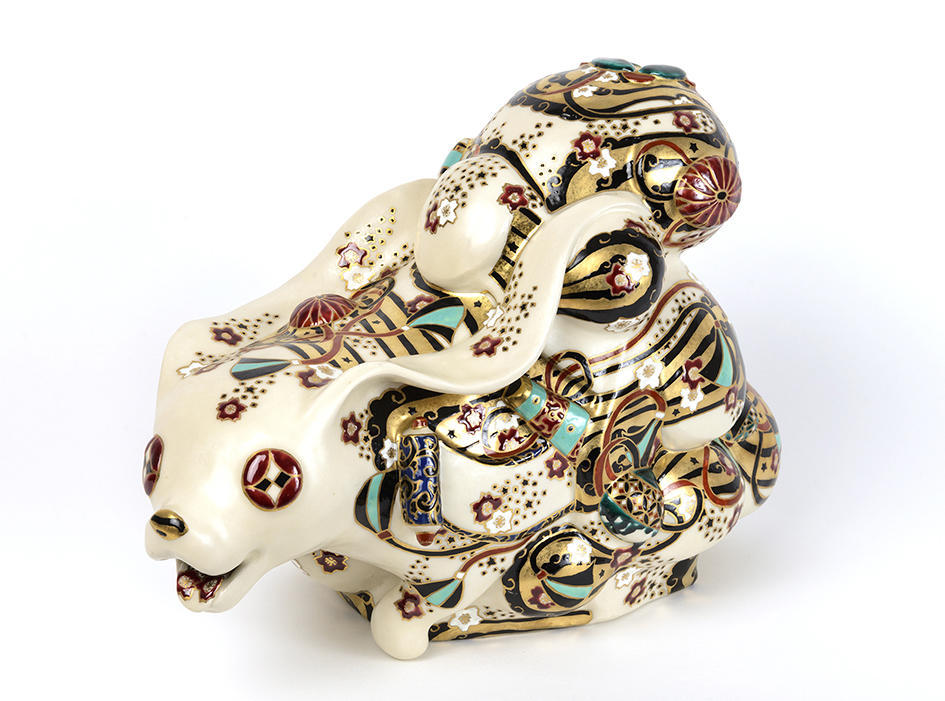
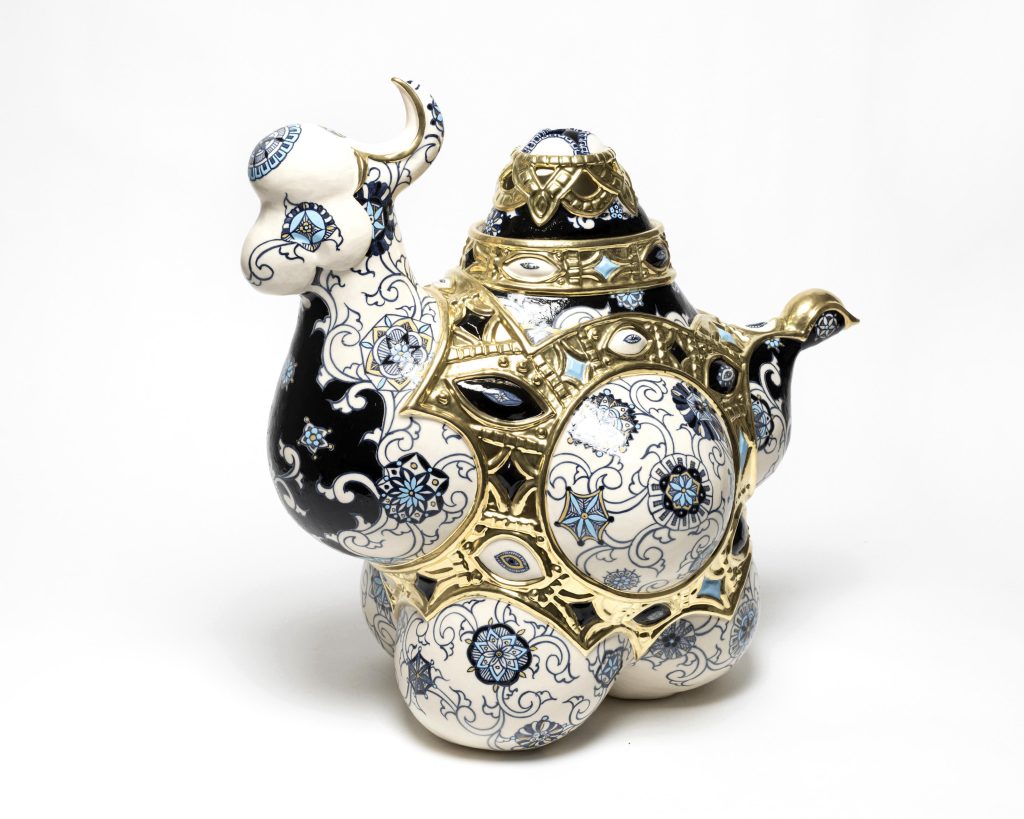
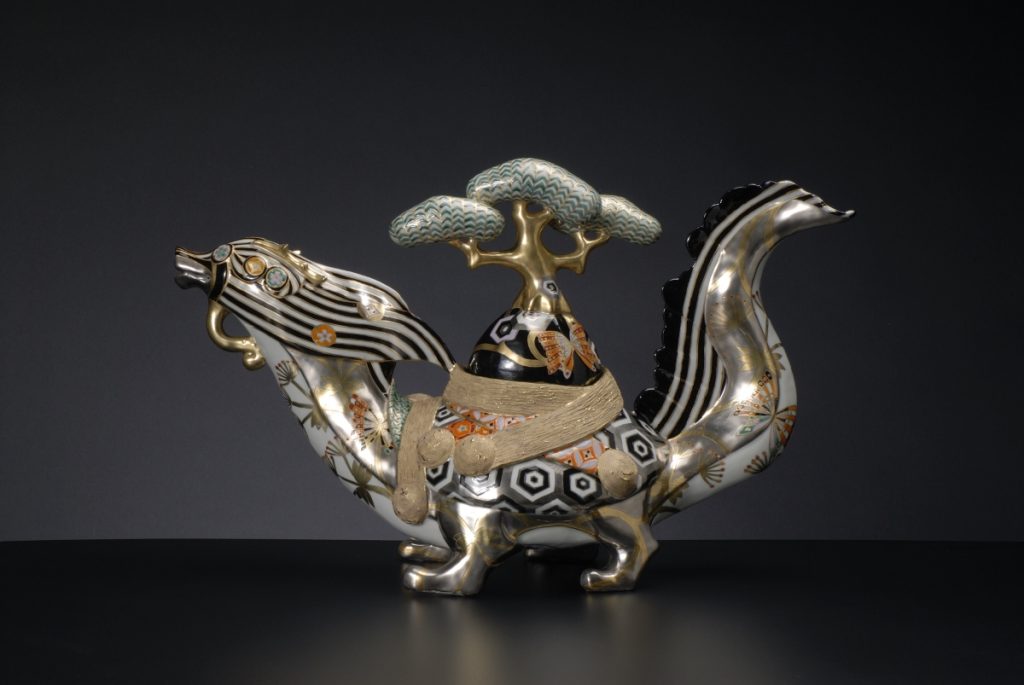
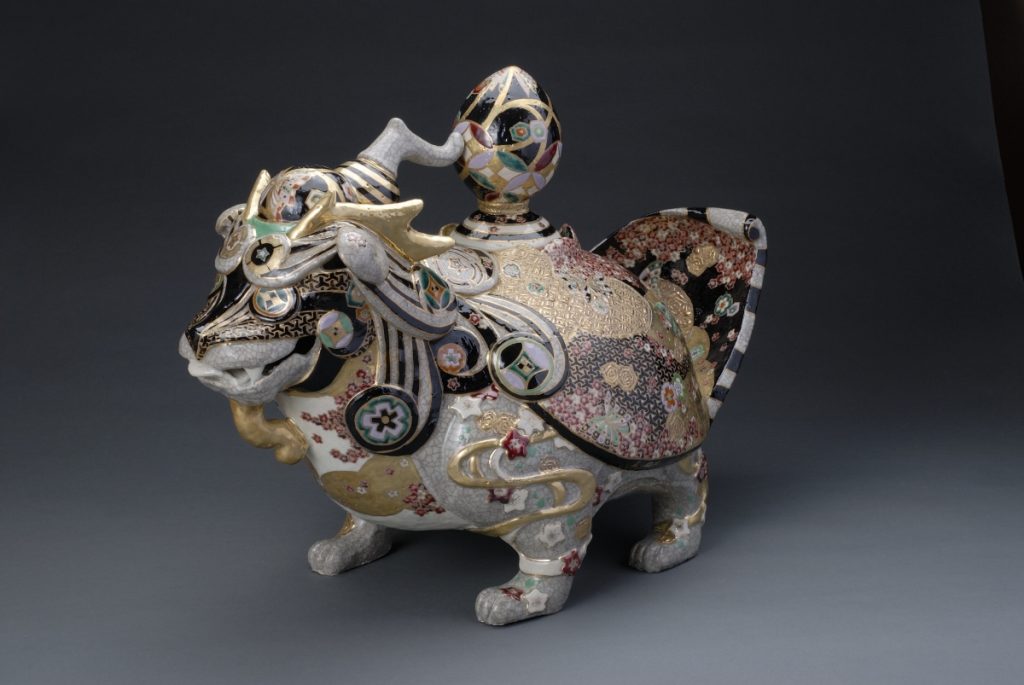
For years, Kasumi has been exploring animal statuary, which she refers to as Chimera. This hybrid monster of ancient Greek mythology is a combination of animal shapes: the head of a lion, the body of a goat, and the tail of a snake. Kasumi applies this construct of the Chimera, in combination with her vivid imagination and vast vocabulary of art historical influence, to create otherworldly, highly decorative compositions that possess the charm and elegance of contemporary Kyoto.
Her hybrid porcelain creatures expand the chimera concept from animals of varied biological or genetic combinations to a luxurious, colorful conglomerate of layered visual information of multicultural meaning. The artist’s treatment of the creature’s form oscillates between bio-morphism, representation, and fantasy. The carved porcelain beasts often contain elements that treat botanical, mythical, or inorganic objects as possible parts to compose a body. This imaginative construction is a type of post-modern eclectic selection based on the artist personal curiosities, experiences, and research. The elaborate and, at times, deep carving and relief appliqué contribute to creating yet another layer that weaves the surface structure to the form and creates increased visual depth. The most interesting element of these porcelain creatures is the artists ability to continuously surprise her audience with increasingly interesting combinations of form and surface. The decoration often appears compulsive, pushing the limits of understanding or typical decoration for adornment or beauty. The surface appears as a variety of finish fetish, an irresistible impulse to tattoo the total form. Viewing the work often requires one to slowly visually decipher and identify each motif, vignette, or pattern, as the power of the initial gaze of the object is overwhelming. Your eyes explore the form, seeking out the limited negative space for orientation while continuously discovering surprise motifs.
Color in the ceramic arts often represents not just an aesthetic but technical challenge, and perhaps it is Kasumi’s use of color relationships or harmonies that possesses the most powerful visual impact. Close glaze surface examination reveals the use of luster as a painting tool to outline the design. The luster-lined design is then colored using enamels manufactured locally in the Kyoto area. The use of specific colorants within the low-firing led fluxed overglaze enamels creates a unique color palette easily identifiable as traditional Kyo-yaki. In comparison, the overglazed enamels produced in Kutani pottery village (Ishikawa Prefecture) create colors with different intensities and hues.
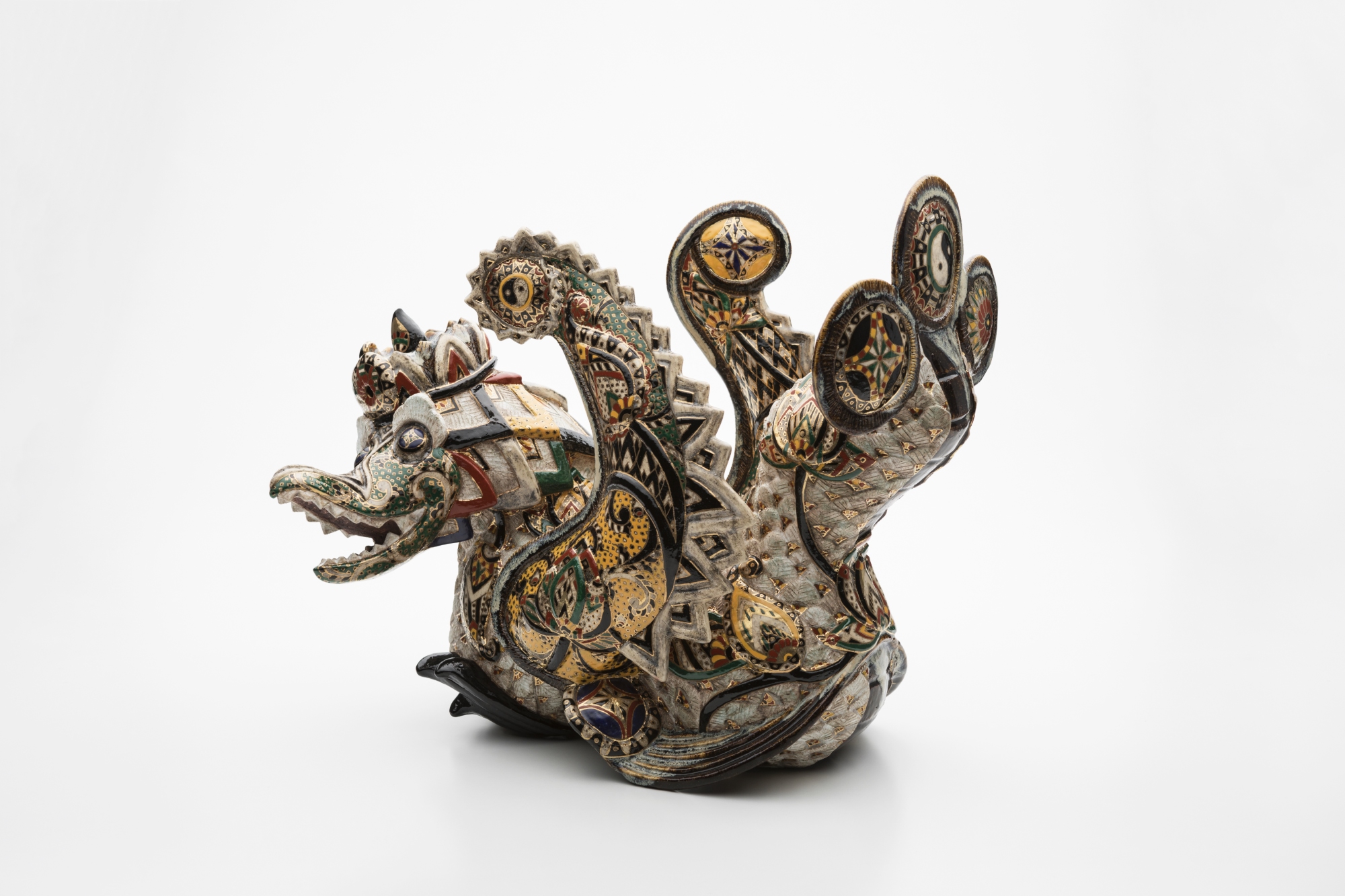
The overglaze selected by Kasumi varies in opacity, and often, transparent, translucent, and opaque overglaze may be employed on a single work. The enamel colors may also be mixed to create new tints and values. To further complicate the glaze matrix we must consider the glaze ground on which she paints. Kasumi applies the overglaze to transparent high fired glazes in both a barium matte clear and calcium fluxed transparent glaze. Sections of the object may also be glaze resisted with wax to provide an unglazed raw clay surface texture. Gold and silver luster, as well as the overglaze enamels, are applied to the matte, transparent, and unglazed sections of the object, resulting in differing overglaze effects dependent on the combined layers of the glaze matrix. Technically, these combinations yield a wealth of variations in surface quality, depth, and complexity.
As humans we all share a desire to decorate. From the spaces we reside to our physical selves. Board any train in Kyoto city, and one is quickly reminded of the diversity of human adornment and bodily decoration in the form of fashion, hairstyles, tattooing and piercing, and cosmetics. Decoration of the self and individual space is viewed as an expression of individuality, especially in a homogeneous society like Japan. However, I fail to understand the pathology of such a deep desire to decorate. Is beauty a type of addiction?
In the northwest corner of Kyoto city, near the grounds of Kenkun Shrine and Daitokuji Temple, one can find Gallery Utsuwakan. The tall and narrow four-floor gallery is festooned with large clay tiles and sculptural relief of ceramic forms, rendering the structure immediately recognizable. Rising to popularity in the 1980s through the representation of contemporary clay pioneers such as Ryoji Koie and later Kato Tsubusa, the gallery is a leader in contemporary Japanese ceramic art. Owned, managed, and operated by Minoru and Mitsuko Umeda for over 40 years, the gallery hosts Kasumi Ueba’s thirteenth solo exhibition at the space this May.
Unlike art exhibitions abroad, there is rarely an opening or closing reception in Japan and no wine and cheese. Instead the artist attends the exhibition most days to meet and greet visitors. However, exhibition attendance is often crowded these days, and conversation time with the artist is in high demand. On May 4, I traveled to the gallery armed with a few concise questions.
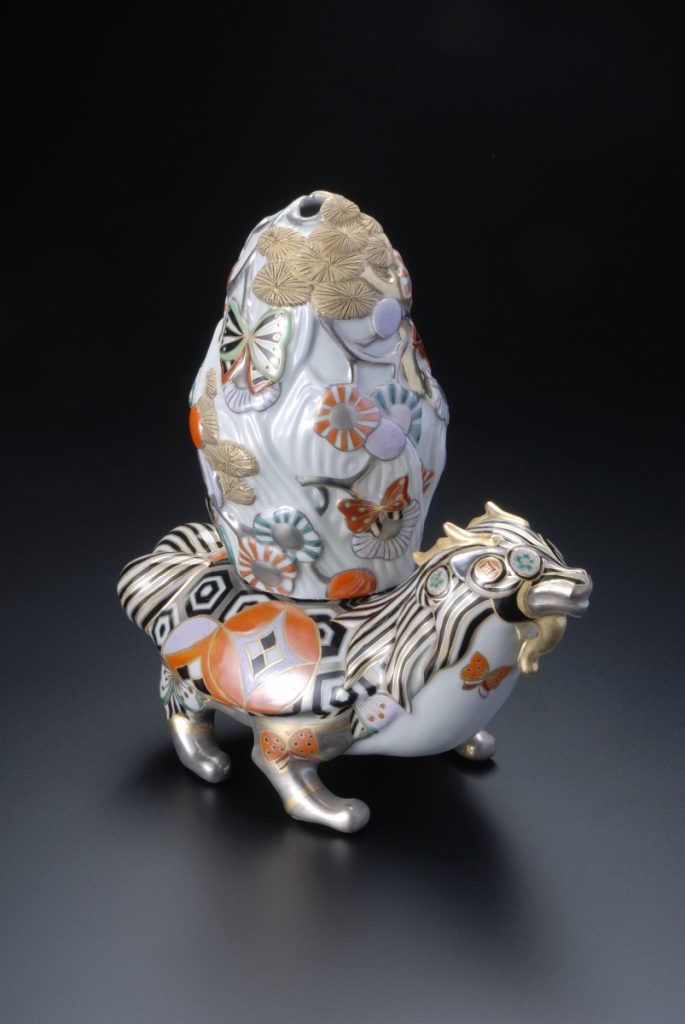
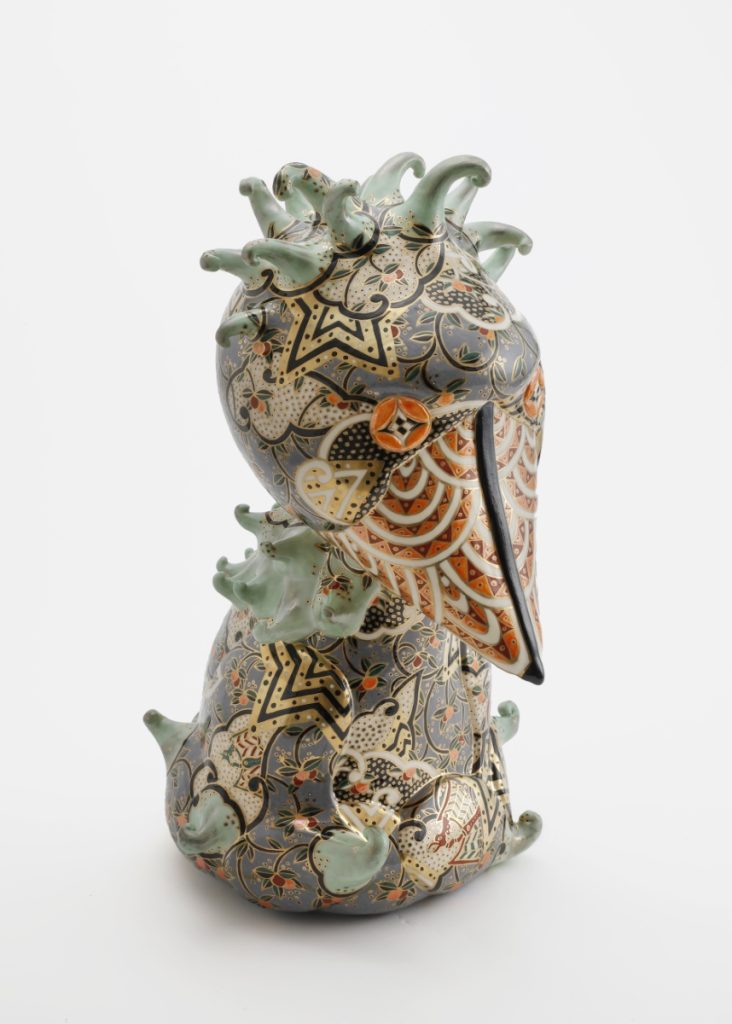
From a small table in the corner of the gallery space, I continued to view the exhibition as conversation naturally bounced between the display, friends of the gallery, and springtime in Kyoto. During a pause, I commented that the new work seemed different to me, particularly in form. I noted several objects were not a conglomerate of animal forms and were not titled Chimera. “Are these new forms derived from…dinosaurs?” I asked.
Kasumi replies, “Yes, dinosaurs…my house if filled with dinosaurs. All my son thinks about is dinosaurs and food. After the first exhibition with the Pokemon Company, I began to think more about making work for my son or wanting him to enjoy what I make. Chimera are like a Pokemon, unrealistic, so I feel complete freedom creating the object…maybe my work is a type of imaginative play. I do not want to repeat ideas in the clay over and over; Chimera has become a bigger concept… so I just follow my interest at the time I am making. It just seems natural to me.”
I replied, “I believe some of these patterns and decorative painting motifs are also new. Can you please comment on the painting process for this exhibition?”
“I always want to make any pattern my own, not just copy an old pattern or try to force it to be contemporary, but really my own. Like how you see a Nara (Nara Yoshitomo) piece… many people paint figures in Japan, but you know a Nara the second you see it. I want my painting and pattern making to be like that, easy to know… this is Kasumi. “
“So what motif is specifically new or yours?” I pushed.
“With all the dinosaur stuff in my house I have learned that dinosaurs were really more like birds, feathered or hairy looking. So… hair, feathers, wings. I imagined plants, fruits and seeds from that time. Like my son’s toys, I wanted to include scars, “battle damage” is what the toy company calls it …I like to use clouds to frame vignettes and tattoo stars.”
She paused and looked back at her work with a small grin as if she felt silly hearing her descriptions out loud, or maybe she was thinking of her child. She continued, “The challenge is coming up with new ideas; most of my thinking is not done when working; it is done between exhibitions. I do not draw or plan anything. Once the idea for a series in is my mind, I directly create… the struggle is really the color combinations. Because the enamels, like regular ceramic glaze, transform color and transparency within the firing process. I test the overglaze on tiles, but the finished piece often has so many colors it is difficult to keep a clear vision of the final post-fired color balance in my mind’s eye.”
I continued, “When we met in Shigaraki, you spoke to me about your travels and your interests in various art forms and cultures. Can you share some recent travel or research and/or foreign influence included in this exhibition or maybe to be used in the near future?”
“I think you are talking about my big trip to Central America… after graduating from university, I took a long trip backpacking through Mexico and Central America. I had very little money, lived on street food…cactus tacos with free toppings, and stayed in cheap hotels. I traveled to experience the festivals and folk art, something I had just seen in books. I wanted to buy a ceremonial mask from a village outside Oaxaca; the trip was a really amazing experience.”
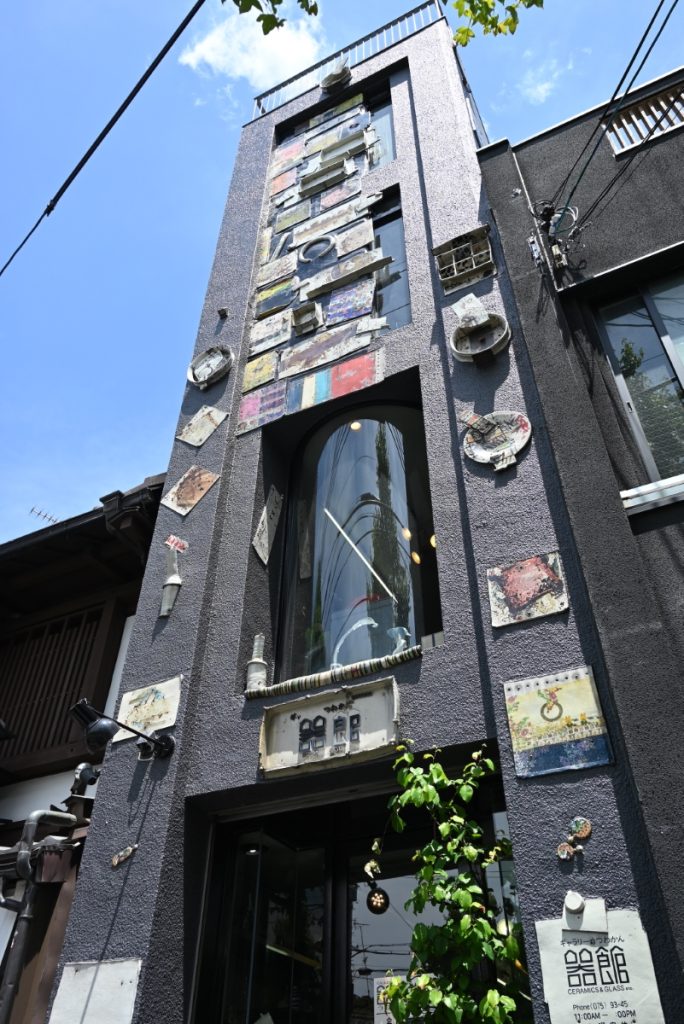
“Since that trip, have you been able to visit other places as sources of new inspiration?” I asked.
“Well, I had a baby during the pandemic, so no, not as much as I like to; maybe that is why I have this dinosaur fascination. I have recently been to the Okinawa Islands a few times, and it is a special place for me. My father was an expert on Okinawa textiles and kimono design and he recently passed away. Okinawa is so tropical, beautiful, and always blooming, and the food culture is such an interesting and unique mix of American and Chinese influences.”
She continued, “Before the pandemic, I traveled and worked in Australia and was invited to jury an exhibition in New Zealand. In New Zealand, I made a new Maori friend, and spending time there with her was inspiring; some aspects of Aboriginal and Maori culture remind me of Japanese Shinto beliefs, a strong reverence for nature, elders, and spirits… I think it is important, especially for Japanese artists, to travel abroad. I think Japanese people have a unique way of interpreting foreign things, not real appropriation; they digest foreign influence and recreate it in a new Japanese way.”
“Like Japanese pizza”, I quipped with a laugh, “with mayonnaise.” Sensing the presence of a new wave of customers I thought it best to depart on a joke and allow Kasumi to visit with her collectors, and I bowed goodbye.
Over fifteen years ago as an artist in residence at the International Center for Ceramic Studies in Shigaraki, I encountered Kasumi Ueba’s Chimera for the first time. Passing her studio space, I witnessed a recently delivered object, and I was overwhelmed, simply stunned. As a technician and artist, I could not understand the mastery of materials before me, this colorful golden cacophony, the layers of surface, the alien form. I simply had never seen anything in ceramic arts like these objects, objects so luxurious, so gorgeous. The object simultaneously seduced and challenged me. As I attempted to formally critique the work in my mind, gazing upon layer after layer of information, I unintentionally grew increasing aware of the cultural assemblage of meaning and traditions within the object that seemed to flow through all of humanity and time.
To be an artist is to hold some fascination of the human experience. I am especially curious about our individual thought processes pertaining to art experiences. When we view new visual information, our brain races through all recorded memory and attempts to categorize it, compare it to similar information, or group it with other similar stimulus. It is human nature to try to lump artwork into groups. For example, this object is wabi, this is post-minimalism, this is neo-mingei. We often lack the vocabulary to express new concepts and visuals we encounter in contemporary clay. Our thought systems break down, and we begin to compare art to other previously experienced art.
Today, we are faced with a level of creativity in the most interesting ceramics that I believe has not previously been experienced. Kasumi Ueba creates such ceramics. Kasumi’s beautiful monsters transcend decorative beauty, as they contain the expressions of our shared collective humanity, remind us of our rich traditions and cultures, and motivate us to continue our self-expression, further explore, and decorate our world with color.
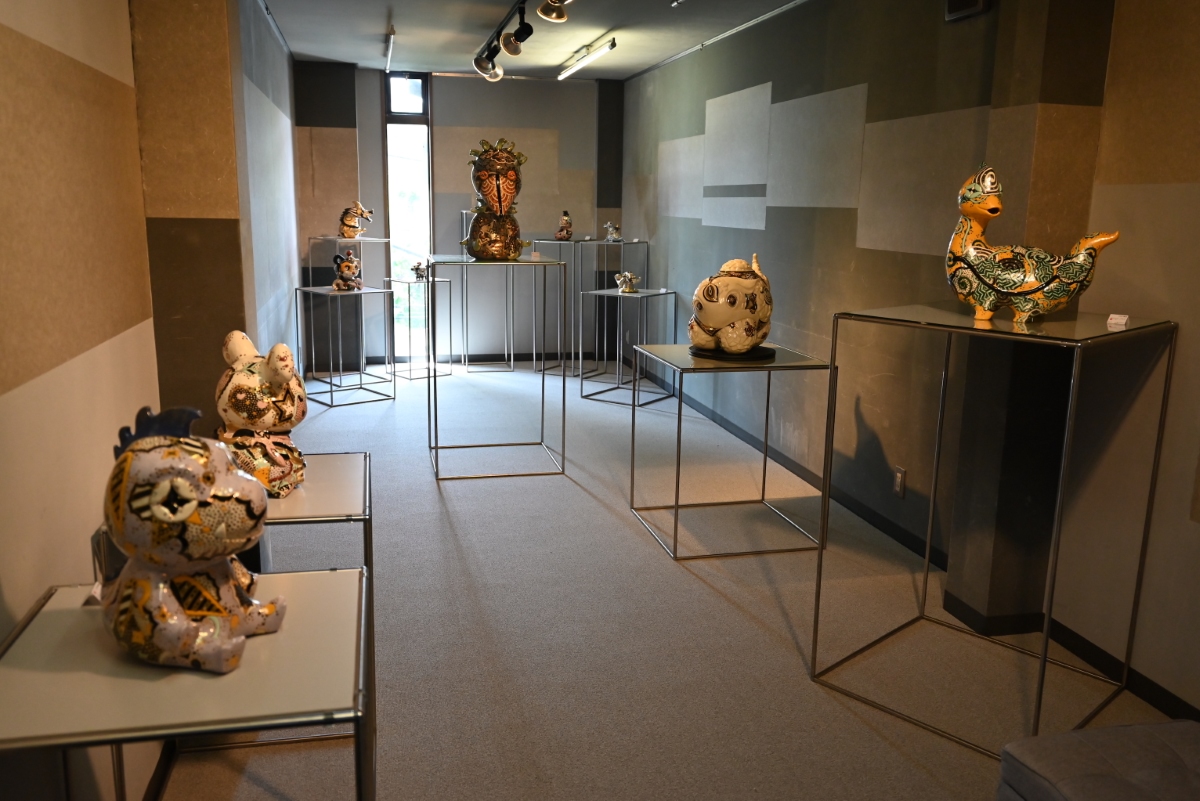
Derek Larsen resides on Mt. Atago outside Kyoto, Japan. In 1998, he constructed his first ramshackle anagama kiln and has been researching anagama techniques ever since. Larsen holds a Master’s in Art in Ceramic Research from Southern Cross University in Lismore, Australia, and is a former professor of art. He has contributed to multiple international art journals, including Ceramics: Art and Perception. He is currently represented by the historic gallery Ginza Kuroda Toen, Tokyo.
Kasumi Ueba’s exhibition was on view at Gallery Utsuwakan, Kyoto, from May 4 to 19, 2024.
Sign up for Ceramics Now Weekly if you’d like to read similar articles on contemporary ceramics.
Captions
- (image 1) Chimera, hand-built and carved porcelain with glaze, luster, and enamels, multiple firings. 2023. Image Credit: Takeru Koroda
- (image 2) Chimera, hand-built and carved porcelain with glaze, luster, and enamels, multiple firings. 2022. Image Credit: Takeru Koroda
- (image 3) Chimera, hand-built and carved porcelain with glaze, luster, and enamels, multiple firings. 2021. Image Credit: Takeru Koroda
- (image 4) Chimera, hand-built and carved porcelain with glaze, luster, and enamels, multiple firings. 2023. Image Credit: Kensei Sugimoto
- (image 5) Chimera, hand-built and carved porcelain with glaze, luster, and enamels, multiple firings. 2023. Image Credit: Kensei Sugimoto
- (image 6) Chimera, hand-built and carved porcelain with glaze, luster, and enamels, multiple firings. 2023. Image Credit: Kensei Sugimoto
- (image 7) Nymph, hand-built and carved porcelain with glaze, luster, and enamels, multiple firings. 2024. Image Credit: Kensei Sugimoto















